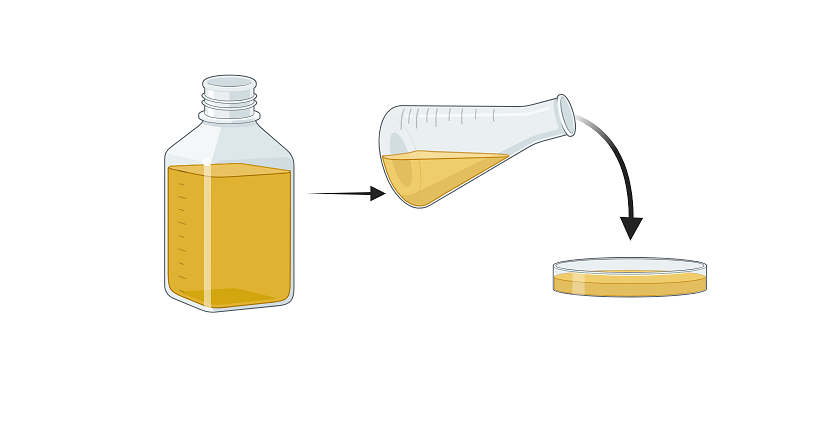Baird–parker agar is a selective medium for the enumeration of Staphylococcus aureus in foods and this was first reported by Baird–Parker. Baird-Parker Agar was developed by Baird Parker in 1962. It is a selective medium for the detection and enumeration of coagulase-positive staphylococci from food samples. Baird-Parker agar is a type of agar used for the selective isolation of gram-positive Staphylococci species. It contains lithium chloride and tellurite to inhibit the growth of alternative microbial flora, while the included pyruvate and glycine promote the growth of Staphylococci.
Selectivity in Baird-Parker is attained with potassium tellurite and lithium chloride. An addition of sulfamezathine is advised only if Proteus species are suspected in the test sample. Sodium pyruvate is a critical component, essential to both recovery of damaged Staphylococcus aureus cells and their subsequent growth. Staphylococcus aureus forms on this medium as grey to black or brown-grey colonies because of tellurite reduction. Staphylococcus aureus colonies with egg yolk factor are surrounded by an opaque zone, frequently with an outer clear zone.
Baird-Parker medium was developed by Baird-Parker to isolate and enumerate coagulase-positive staphylococci from foods. The present formulation, by Baird-Parker, is a modification from a previous formula developed by Zebovitz, Evan, and Niven. Sodium pyruvate was added as a selective growth stimulant, and egg yolk emulsion as a differentiation agent. The medium allows growth of Staphylococcus aureus and selectively inhibits growth of most other bacteria.
Selective inhibition is thought to be caused by the combination of the selective agents tellurite and lithium. Glycine and pyruvate are added to enhance the growth of staphylococci.
After 24 to 48 hours of incubation at 35-37ºC., colonies of S. aureus will appear black, convex, shiny, and 1-1.5mm in diameter. The very distinct black colonies formed by S. aureus are a result of the reduction of tellurite in the medium. These colonies will normally be surrounded by clear zones, a result of proteolysis or lipolysis. Occasionally, opaque zones will form within this clear zone, a result of lipase or lecithinase activity. Other bacteria which may grow on this medium are easily distinguished from S. aureus, as they do not form black colonies.
As a nitrogen source for the organism, casein peptone and meat extract are added to the medium. Yeast extract provides nitrogen as well as other important nutrients like vitamin B12 complex. The medium contains lithium and tellurite, which inhibit most of the contaminating microflora, while glycine and pyruvate enhance Staphylococci growth. Staphylococci can reduce tellurite to telluride, which results in grey to black coloration of the colonies. With the addition of egg yolk, the medium becomes yellow, slightly opaque. A clear halo develops around colonies from coagulase positive Staphylococcus aureus, and upon further incubation may produce an opaque zone due to an egg yolk – lecithinase reaction (lypolytic activity). Grey-black colonies and a halo on this medium are presumed to be indicative of coagulase positive staphylococci, as a high correlation between coagulase test and lipophylitic activity was found. Staphylococcus aureus and some strains of Staphylococcus saprophyticus may show both of these characteristics, but they are easily distinguished from each other by the different times at which the halo develops.
Components of Baird–parker agar
Ingredients per 940ml of deionized water:*
| Glycine | 12.0gm |
| Pancreatic Digest of Casein | 10.0gm |
| Sodium Pyruvate | 10.0gm |
| Beef Extract | 5.0gm |
| Lithium Chloride | 5.0gm |
| Yeast Extract | 1.0gm |
| Egg Yolk Tellurite Enrichment | 60.0ml |
| Agar | 20.0gm |
Final pH 7.0 +/- 0.2 at 25ºC.
* Adjusted and/or supplemented as required to meet performance criteria.
DirectionsSuspend 63g in one litre of distilled water and boil to dissolve the medium and sterilise by autoclaving at 121°C for 15 minutes. Cool to 50°C and aseptically add 50ml of Egg Yolk Tellurite Emulsion (SR0054). Alternatively, 50ml of Egg Yolk Emulsion (SR0047) and 3ml of Potassium Tellurite 3.5% (SR0030) can be used. Mix well before pouring into sterile Petri Dishes.
Table 1: Colony characteristics of typical organisms on Baird-Parker Egg Yolk Tellurite Medium
| Organism | Growth | Colony |
| Staphylococcus aureus | Good | Grey-black shiny convex 1-1.5 mm diameter (18 hours) up to 3 mm (48 hours) narrow white entire margin surrounded by zone of clearing 2-5mm |
| Staphylococcus epidermidis | Variable | Not shiny black and seldom produces clearing |
| Staphylococcus saprophyticus | Variable | Irregular and may produce clearing. Wide opaque zones may be produced in 24hrs |
| Micrococcus species | Variable | Very small in shades of brown and black. No clearing |
| Bacillus species | Variable | Dark brown matt with occasional clearing after 48hrs |
| Escherichia coli | Variable | Large brown-black |
| Proteus species | Variable | Brown-black with no clearing |
| Yeasts | Variable | White, no clearing |
References
Baird-Parker A. C. (1962) J. Appl. Bact. 25. 12-19.
Zebovitz E., Evans J. B. and Niven C. F. (1955) J. Bact. 70. 686-689.
Baird-Parker A. C. (1963) J. Gen. Microbiol. 30. 409-413.
Chopin A., Malcolm S., Jarvis G., Asperger H., Beckers H. J., Bertona A. M., Cominazzini C., Carini S., Lodi R., Hahn G., Heeschen W., Jans J. A., Jervis D., I., Lanier J. M., O’Connor F., Rea M., Rossi J., Seligmann R., Tesone S., Waes G., Mocquot G. and Pivnick H. (1985) ICMSF Methods studies XV. J. Food Protect. 48. 21-27.
Discover more from Microbiology Class
Subscribe to get the latest posts sent to your email.





